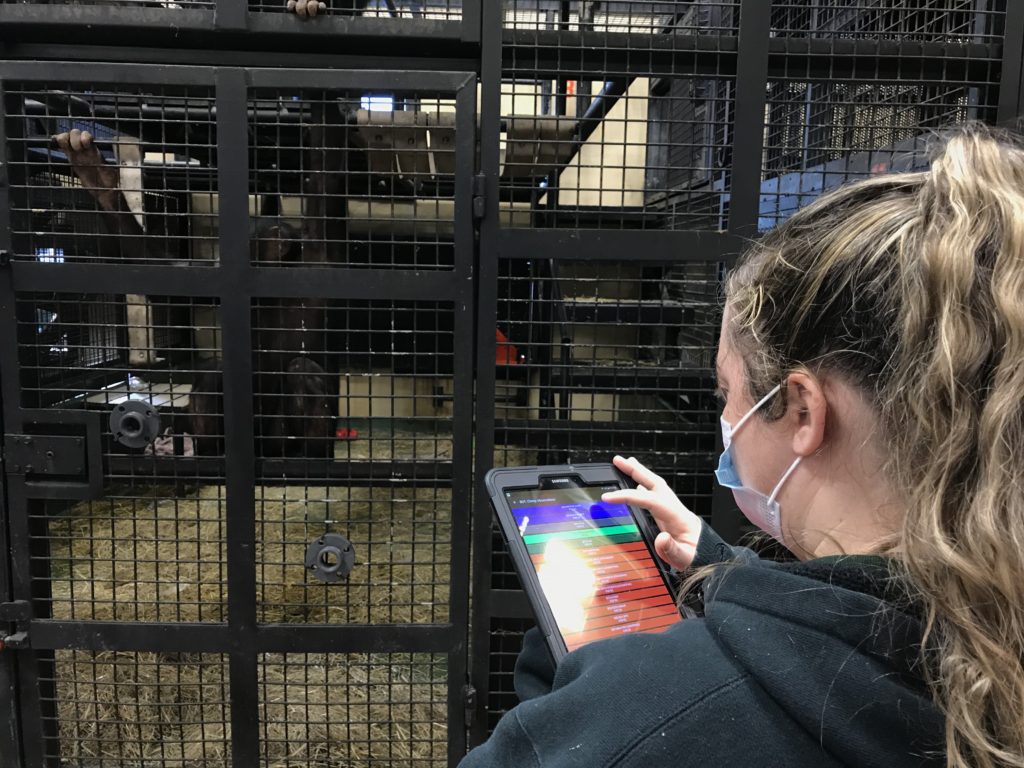
The BOT Tool to Track Abnormal Behaviors

by Kayla Adgate
In last week’s blog post “Abnormal Behavior in Chimpanzees,” we were given a broad look into the different abnormal behaviors chimpanzees experience, and what caregivers can do to mitigate them. Today, we are excited to provide an inside look into the day to day life of Project Chimp’s Behavior Coordinator, Kate Donovan, as she gives us an in-depth look into how she assesses and tracks abnormal behaviors and works to promote the chimp’s psychological well-being.
Kate compares most abnormal chimp behaviors to a toddler sucking their thumb. Rocking, thumb sucking and head-bobbing, for example, are self-soothing behaviors that, in most cases, chimps have been doing all of their lives to cope with stress. These are harmless behaviors that do not harm the chimp’s themselves, or other members of their social group. If a chimp, for example, has always rocked as a coping mechanism, there is little cause for concern. However, Kate says that if caregivers notice that a chimp who does not have a history of rocking suddenly begins rocking, then they would observe this chimp very carefully.
The BOT Tool in the Field
One nifty tool that caregivers use to assess abnormal behaviors is caused the Behavior Observation Tool, developed by Eric Simonton, founder of the company Simonton Software. The BOT allows caregivers to track the frequency and prevalence of abnormal behaviors over time. Kate states this tool is extremely useful. Often in the field without this technology, caregivers may over or underestimate the frequency of a chimp’s display of abnormal behaviors. The BOT is a more accurate way to measure and store this data over time to gauge long-term well-being.
How does it work in the field? Kate walks the sanctuary with her tablet throughout different times of the day, recording data such as the type of abnormal behavior a chimp is displaying and how many times it occurs. Kate pays particular attention to any chimps caretakers have noted that may be displaying signs of abnormal behavior. Each of Kate’s sessions are at least thirty minutes long. For some reason, Kate catches most abnormal behaviors at mealtimes, so this is a time that she pays particular attention to.

Why is it important to track abnormal behaviors?
A chimp’s well-being is intimately connected to their physical health, emotions, and psychological well-being. Abnormal behaviors are a sign that something is off. Once caretakers notice a chimp displaying abnormal behavior, the trial and error begins. Kate says “A chimp may partake in these behaviors when they don’t feel well, are in pain, or are stressed out, so it’s important to conduct observations to gather as much data as possible so that we can narrow down what might be going on.”
For example, if caregivers realize that a chimp is under stress, they might try to move the chimp to a more productive social dynamic. Or, the team might provide a chimp extra enrichment activities. If the underlying issue it is determined to be medical, the caregivers work closely with the medical team to find healthy solutions.
To Kate, its most important to get the chimps back to being able to enjoy their retirement in peace.
Please consider donating to ensure we always have access to the tools and treatments we need for the chimps.

Kayla Adgate is a Spring 2021 Communications Intern.
